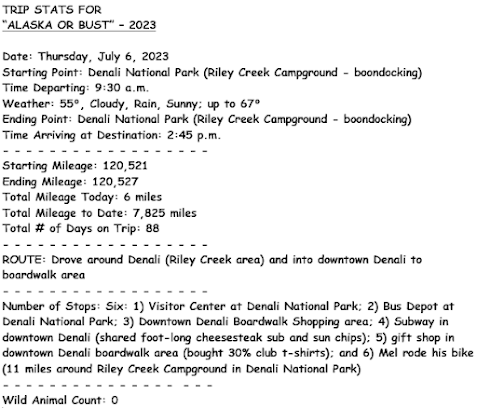Today started out at 55 degrees and cloudy with some rain . After breakfast, we decided to go over to the Denali National Park Visitor Center.
We drove past the Denali Bus Depot on our way to the visitor center.
The map below shows where all the buildings are located in the Denali National Park.
The sign below shows the bus route -- although the bus only goes to mile 43 due to the road closure because of the Pretty Rocks Slide.
Mel approaches the Denali National Park Visitor Center, where we decided to watch the two films being shown: 1) Heartbeats of Denali (Denali through the seasons) and 2) The True Heart of Winter (The story of Denali's sled dogs).
After watching the films, we walked around looking at the exhibits. The sign below tells all the different names given to "The Great One" aka Denali.
The sign below tells of the hearty adventurers who were the first to reach the summit of Denali.
Above picture shows the lobby area in the visitor from the second floor.
The sign above talks about President Jimmy Carter and his signing the "Alaska National Interest Lands Conservation Act" or ANILCA, which was enacted to protect Alaska's wild in 1980. It set aside 106 million acres of federal public lands, classifying these as national parks, preserves, forests, wilderness areas, wildlife refuges, national recreation areas, and wild and scenic rivers. (See below on the map -- the light yellow shows the areas that were added due to the ANILCA.)
Above is one of the oil paintings (on four wood panels) created by a artist-in-residence in 2012, Deborah Bouchette. In describing the painting she called "The Soul of the Wolf Cries," she indicated that she was mindful of the movements of wild animals as well as the importance of our stewardship in interacting with the ecosystem. She incorporated all the place names she found on the old USGS maps in the East Fork cabin as symbolic of our interventions here.
Above and below are maps to help plan our trip or a hike or two at Denali.
And early visitors truly had the park to themselves with the sheep outnumbering the first tourists 500 to one.
Fannie Quigley was one of Alaska's most colorful pioneers (see above). Below is the recipe of Fannie Quigley's Blueberry Pie.
Above is what a gold miner's cabin might have looked like in Kantishna.
The picture above explains how the Athabaskan people relied on the land to provide, while the picture below shows the actual items used.
Above is a map showing the five Athabaskan groups that were the first inhabitants of the land.
There are many hiking trails or simply walks that you can take in Denali.
Mel walks into the Denali Park Depot, while people below wait to board the train.
The Wilderness Express train in Denali.
The subarctic wilderness made the laying of rail difficult.
The Savage River Tourist Camp provided a tent furnished with an iron bed and coil spring mattress, a table and chairs and a small wood stove. At Savage Camp, they ate their meals in the dining hall and attended lectures and dances in the social hall -- when they weren't exploring the park by horse, stagecoach or car.
Curry was a palace in the wilderness with modern, inviting and comfortable accommodations. It is now deserted however.
When the railroad station was built in 1922, on land outside the park boundaries, there was already a tiny settlement here. It came to be known as McKinley Park Station.
Bridges helped to "bridge the gaps" for the railroad, crossing gorges, creeks and rivers. As we left the train depot, the sky was getting rather dark and looking like it could rain again at anytime.
We decided to drive to the Denali boardwalk area, which has an array of different businesses.
While we were in the boardwalk area, we ate lunch at Subway (we split a foot-long cheese steak sub sandwich and had sun chips).
After lunch, we walked through the shops and found the "I Saw Denali 30% Club" t-shirts. (We actually belong to the 10% club as we saw Denali in its entirety, but these t-shirts were too cool, we couldn't pass them up.)
Rain can't dampen our spirits, even though we have had more than our share.
Shirley & Mel






















































No comments:
Post a Comment